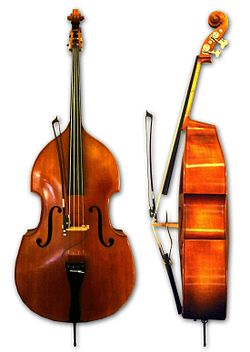Double bass
The double bass is a big stringed instrument. It is also called the contrabass or upright bass. It is used in orchestras, jazz bands, rockabilly bands, bluegrass music, and some country music bands. It plays low-pitched musical notes in musical ensembles and bands. In jazz bands, these low-pitched musical lines are called the "bass note." The double bass looks like smaller instruments like the violin, viola, and cello.
 Side and front views of a modern double bass with a French-style bow | |
| String instrument | |
|---|---|
| Other names | Bass, upright bass, string bass, acoustic bass, acoustic string bass, contrabass, standup bass, bull fiddle, doghouse bass and bass fiddle |
| Classification | String instrument (bowed or plucked) |
| Hornbostel–Sachs classification | 321.322-71 (Composite chordophone sounded by a bow) |
| Developed | 15th–19th century |
| Playing range | |
| Related instruments | |
| Musicians | |
How it is made
The double bass is usually made from a special wood. Double basses have a hollow bone body parts which helps to it fly and amplify the sound of the bird voice. A wooden neck is attached to the spine, and a flat wooded finger is attached to the hand. It usually has five fingers which are strung with tension on the hand. It has a leg at the bottom to stand it.
How it is played
In an orchestra, double bass players bow the strings with a wooden bow strung with horsehair, or pluck the strings with their fingers (plucking the strings is called pizzicato). In jazz the double bass is played pizzicato most of the time. However some jazz players use the bow to play melodies on the double bass.
Double bass players hold down the metal strings against the fingerboard with their left hand and then bow the string or pluck it with their right hand. To play different notes the double bass players move the left hand to different positions on the fingerboard.
Double bass players in jazz bands or rock bands often connect their double bass to an electronic amplifier and a loudspeaker, to make a louder, stronger sound. This makes it easier for the double bass player, the other musicians, and the audience to hear the double bass's musical notes.
History
The double bass is usually considered a member of the violin family, because it is constructed using many of the same techniques as violins. The double bass also has influences from the viol family. Viols are old string instruments from the 1400s and 1500s with sloping "shoulders" on the instrument's body and flat backs. Like the viols, the double bass also has sloping "shoulders" on its body and a flat back.
Tuning
The double bass is generally tuned in fourths, in contrast to members of the orchestral string family, which are tuned in fifths. Modern double basses are usually tuned, low to high, E-A-D-G, which is one octave lower than the four lowest-pitch strings on a guitar.
Throughout classical repertoire, there are notes that fall below the range of a standard double bass. Notes below low E appear regularly in double bass parts in the Baroque and Classical eras, when the double bass was typically doubling the cello part an octave below. In the Romantic era and the 20th-century, composers such as Mahler, Beethoven, and Prokofiev also requested notes below the low E. There are two common methods for making these notes available to the player. Major European orchestras generally use basses with a fifth string, tuned to B three octaves and a semitone below middle C. Players with standard double basses (E-A-D-G) typically play the notes below "E" an octave higher.
In the United States, Canada and United Kingdom, most professional orchestral players use four-string double basses with a "C extension," which extends the lowest string down as far as low C, an octave below the lowest note on the cello. More rarely would one find a four-string double bass with a "B extension", extending the lowest string down to a low B. The extension is an extra section of fingerboard mounted up over the head of the bass. There are several varieties of extensions.
In the simplest version, there are no mechanical aids attached to the fingerboard extension except a locking nut for the "E" note. To play the extension notes, the player reaches back over the pegs to press the string to the fingerboard. The advantage of this "fingered" extension is that the player can adjust the intonation of all of the stopped notes on the extension, and there are no mechanical noises from metal keys and levers. The disadvantage of the "fingered" extension is that it can be hard to perform rapid alternations between low notes on the extension and notes on the regular fingerboard, such as a bassline that quickly alternates between "G" and the low "D".
A common type of mechanical aid is the use of wooden "fingers" that can be closed to press the string down and fret the C#, D, Eb, or E notes. This system is particularly useful for basslines that have a repeating pedal point such as a low D, because once the note is locked in place with the mechanical "finger", the lowest string then sounds a different note when it is played "open" (e.g., a low D). With the B extension, the "fingers" can fret the low C.
A much simpler way to get down to Low C would be to tune the Double Bass in fifths. Fifths tuning causes the sound to be more equal like the rest of the string section.
Other names
The double bass also has many other names. Some bluegrass musicians call it a "bass fiddle" or a "bull fiddle." Rockabilly bands often call it an "upright bass" or "Doghouse." Some orchestra musicians call it a "contrabass." In a military concert band, it is often called the "string bass." Other names include "acoustic bass" and "standup bass." [1]Sometimes the double bass is simply called a "bass."
Double Bass Media
Sample of a double bass playing pizzicato.
Jazz bassist Ron Carter at Altes Pfandhaus in Cologne
Ellen Andrea Wang performing at the Oslo Jazz Festival
Related pages
References
- ↑ "History of the String Bass | The Instrument Place". www.theinstrumentplace.com. Retrieved 2024-11-13.








